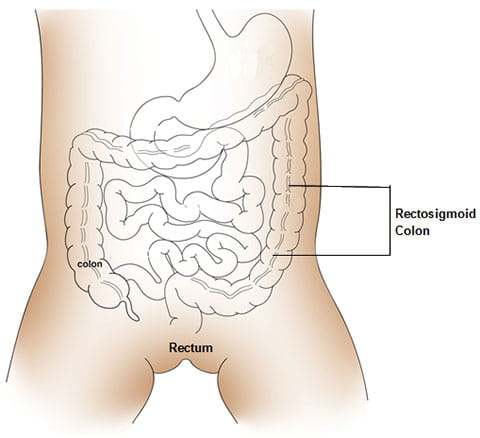How Do Anorectal Malformations Affect Fecal Incontinence?
Bowel control depends on three main factors:
- Sensation (feeling)
- Movement of the colon (called motility)
- The muscles or sphincter around the anus
Having an anorectal malformation likely means that one or all of these factors did not form the right way. This can range from a minor lack of forming to not forming at all.
Sensation within the Rectum
Children born with anorectal malformations often lack some degree of sensation, meaning they are not able to feel stool or gas pass through their rectum. The child may have no feeling at all or may be able to feel solid stool, but not loose stool. Many times the child may soil their pants without knowing it. They may also get used to the smell of their stool and not realize they soiled their pants based upon smell.Motility of the Colon

The rectosigmoid colon is the part of the bowel where stool collects and is “stored” between bowel movements. In most cases, the rectosigmoid is quiet for about 24 hours. This is the time needed to collect the stool. Then a big contraction allows it to fully empty the stool. After stool leaves the body, the rectosigmoid is quiet again.
If the rectosigmoid is slow, the stool stays in the rectum. Constipation occurs and the child may suffer from soiling. The soil or smears in the underwear is caused by liquid stool higher up in the colon leaking around the hard stool. On the other hand, if a child has no rectosigmoid (due to surgery), they may pass stool more frequently.
What Is a Voluntary Sphincter and Why Is It Important?
The voluntary sphincter is a group of muscles that surround the rectum and anus. These muscles are vital for bowel control.
- In children with anorectal malformations, these muscles are less developed and are not able to keep the stool from leaking out.
- The more complex the anorectal malformation, the sphincter muscles are less developed.
- It is important for the placement of the rectum to be within the limits of the sphincter at the time of the child’s Pull-Through / PSARP surgery.
Are There Things that Help Predict Good Bowel Control?
After the main repair, and for some patients the colostomy closure, the surgeon can predict if the child may have good bowel control.
Indicators of Potential for Good Bowel Control
- Normal sacrum (lowest part of the spine / backbone)
- Well-formed buttocks muscles
- Some types of anorectal malformations. These include: rectal atresia, vestibular fistula, imperforate anus without fistula, rectourethral fistula, cloaca with less than 3cm common channel, perineal fistula.
Indicators of Potential for Poor Bowel Control
- Abnormal sacrum (lowest part of the spine / backbone)
- Flat buttocks (poor muscles)
- The presence of a tethered spinal cord (spinal cord abnormally attached to the spine)
- Some types of anorectal malformations. These include: rectobladderneck fistula, cloaca with greater than 3cm common channel, complex malformations.
What Determines How Well My Child Is Doing?
Children with good bowel control will have:
- Good bowel movement patterns. They will have one to two bowel movements per day with no soiling in between.
- Signs of feeling when passing stool (pushing, making faces)
- Urinary control
Children with good bowel control may have soiling if they:
- Have a viral illness
- Take medicine that causes diarrhea (for example, antibiotics)
- Become constipated
When the cause of the diarrhea has resolved (a viral illness or medicine), they should get their bowel control back.
Children with poor bowel control may have:
- Soiling accidents and passing stool all the time with no control over the bowel movements
- No signs of feeling when passing stool (no pushing, making faces or saying they have to go)
- No urinary control or dribbling of urine
Understanding your child's chances for bowel control may take some time, but it is helpful with the management of care later on in life. Since there are a wide range of defects within the anorectal malformation diagnosis, we should expect a wide range of results of bowel function.
Anorectal Defects Linked to Poor Outcomes
If the child's type of defect is linked with a poor outcome, they will likely have to start a bowel management program with a daily enema to stay clean of stool.
For these children, this program with a daily enema should be started when the child is 3 or 4 years old, or when their peers are out of diapers.
We always give each child the chance to prove their potential for bowel control. Children who have poor bowel control now may become more aware of their bodies as they get older. When this happens, we can try a program that does not have a daily enema.



